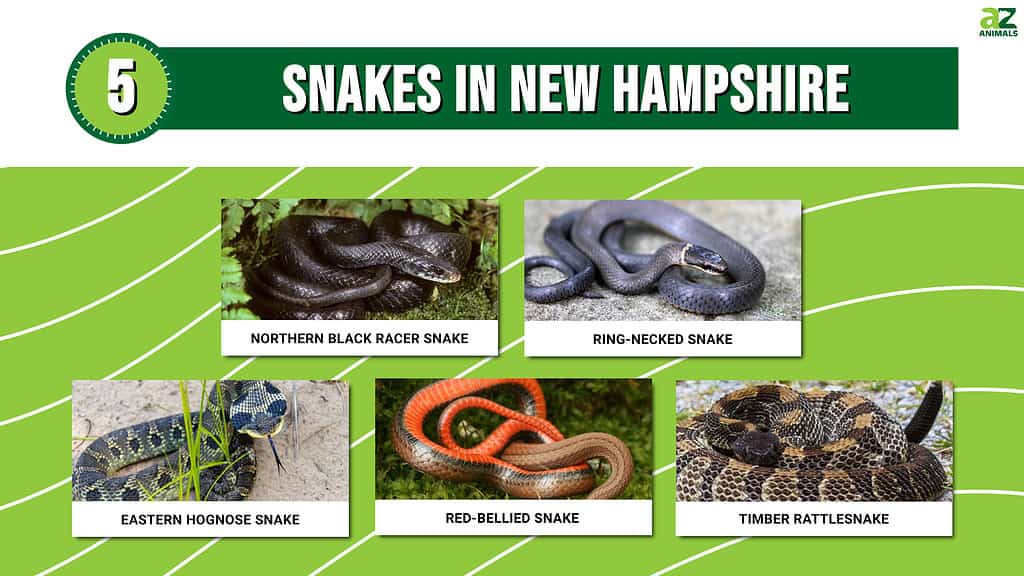
There is only one venomous species of snake in New Hampshire.
©
The Granite State has a long history, extending to the very beginning of the settlement of the United States. Even so, it doesn’t have a big population. New Hampshire’s geography includes mountains, beaches, and plenty of forests and grasslands. The geographic diversity makes New Hampshire a terrific home for snakes that thrive in the cooler northern climate that it offers.
And, if you’re worried about venomous snakes, there is only one species in New Hampshire. So, the chance that you will see one is small. You’re more likely to see a few of the nonvenomous snakes in New Hampshire if you like outdoor activities like kayaking, boating, hiking, and mountain biking.
Let’s explore New Hampshire’s snakes.
Northern Water Snake (Nerodia sipedon)
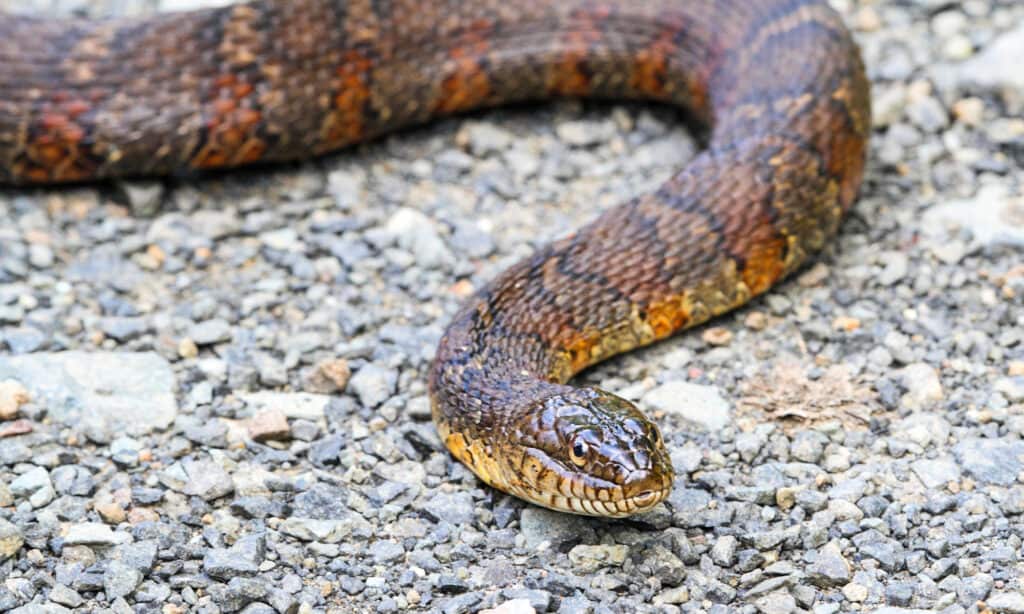
Northern watersnakes are one of the most widespread watersnakes in North America.
©Steve Byland/Shutterstock.com
Harmless northern watersnakes aren’t as scary as they look! Their body size and coloring mimics the size and coloring of a cottonmouth snake or a copperhead snake. However, they aren’t venomous.
Usually a northern water snake stays smaller than four feet long, but it can reach four and a half feet. Water snakes are very common throughout most of southeast New Hampshire. They like the water but also move about on the land and in the marshes near lakes and waterways. These snakes sometimes climb tree branches that sit just above the water and watch for prey in the water below — mostly fish and amphibians.
Northern Black Racer Snake (Coluber constrictor)
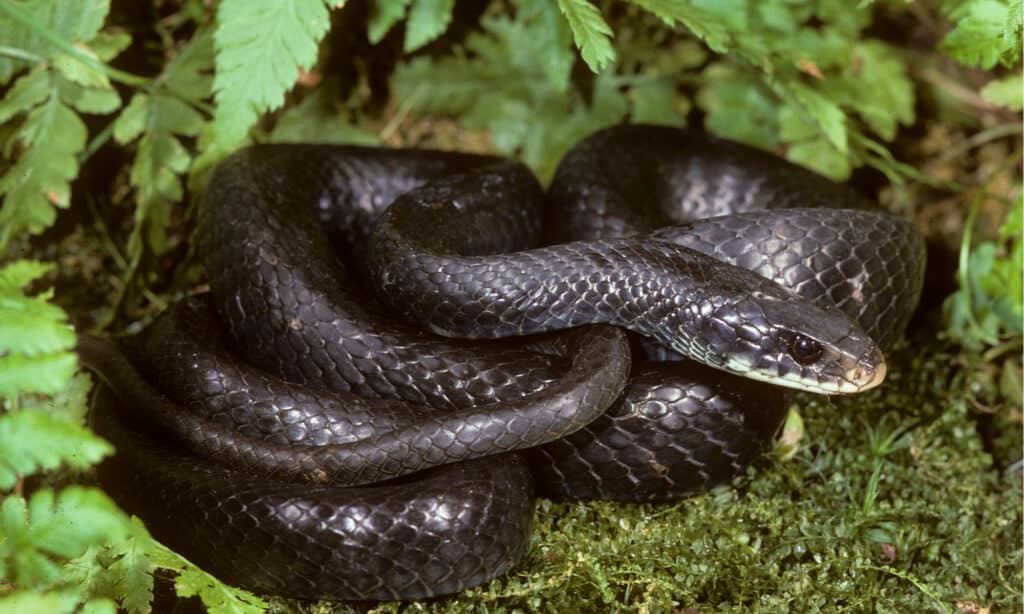
Northern Black Racers (Coluber constrictor) are quick-moving snakes.
©Breck P. Kent/Shutterstock.com
In New Hampshire, you will usually find northern black racer snakes south of the White Mountains. Northern black racers like areas with heavy brush, thick grasslands, or the edges of forested areas. These snakes are not very long. The biggest ones are just over five feet long and most are between four and five feet long. They are dark green or black in color and they are very fast.
If you are out hiking or walking and you see a northern black racer it’s probably going to disappear as quickly as it came. In fact you might only see a blur of movement and then nothing. If given the chance this snake would rather get away from you as quickly as possible rather than attack you.
These snakes eat a little of anything they can overpower, including small rodents, birds, and sometimes other snakes.
Ring-Necked Snake (Diadophis punctatus)
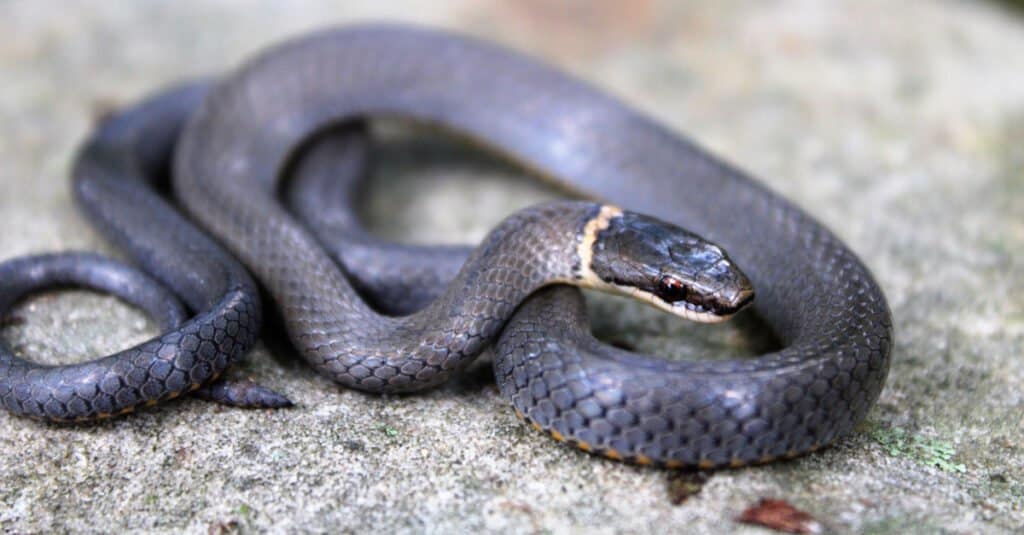
Ring-Necked snakes are strictly nocturnal.
©Tucker Heptinstall/Shutterstock.com
Sporting a distinctive neck band, ring-necked snakes are usually easy to spot. Even though their body color is dark and can be dark brown, olive, or even black you can tell a Ring-Necked snake by the bright ring of color around their neck. The ring on the neck of a Ring-Necked snake is usually red, yellow, or orange. But it’s unlikely you will ever see one near you unless you are out hiking or walking late at night.
Ring-necked snakes are strictly nocturnal and prefer to hide as much as possible during the day. These snakes hide under rotten logs, leaf litter, and other debris during the day, which is where a lot of their prey also hides. Ring-necked snakes eat They have been known to share dens with other types of snakes, especially during the winter when they go dormant until the weather warms up.
Eastern Hognose Snake (Heterodon platirhinos)
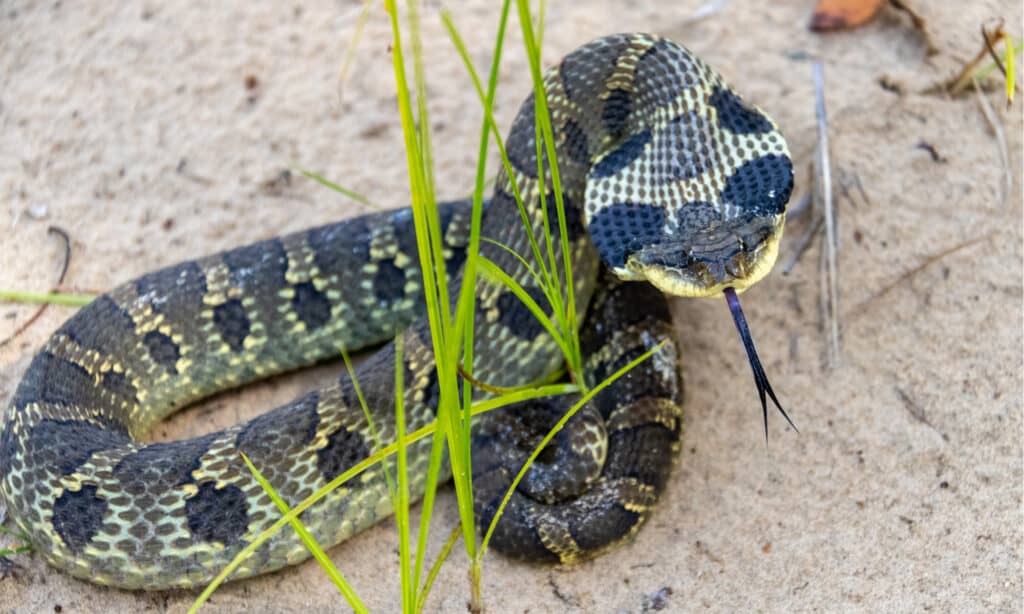
Eastern Hognose Snakes have rectangular spots down the middle of the back that may resemble eyespots.
©IHX/Shutterstock.com
The eastern hognose snake is small. It’s generally around three feet long but many snakes top out at just two feet. You can recognize a Hognose snake by the upturned nasal scales that give it a swine-like appearance.
Hognose snakes use their snout to dig into dirt to hunt and burrow when they need to rest. A hognose snake may puff up and try to act threatening if it perceives you as a threat but it quickly moves on to playing dead. The act isn’t complete until its tongue is hanging out and it’s belly up.
These snakes are technically venomous, but not dangerous to people. Hognose venom is so mild that the only real danger is a little irritation if it bites, which is uncommon. This species eats toads and other amphibians, so it stays near moist sandy areas that will support their prey.
Red-Bellied Snake (Storeria occipitomaculata)
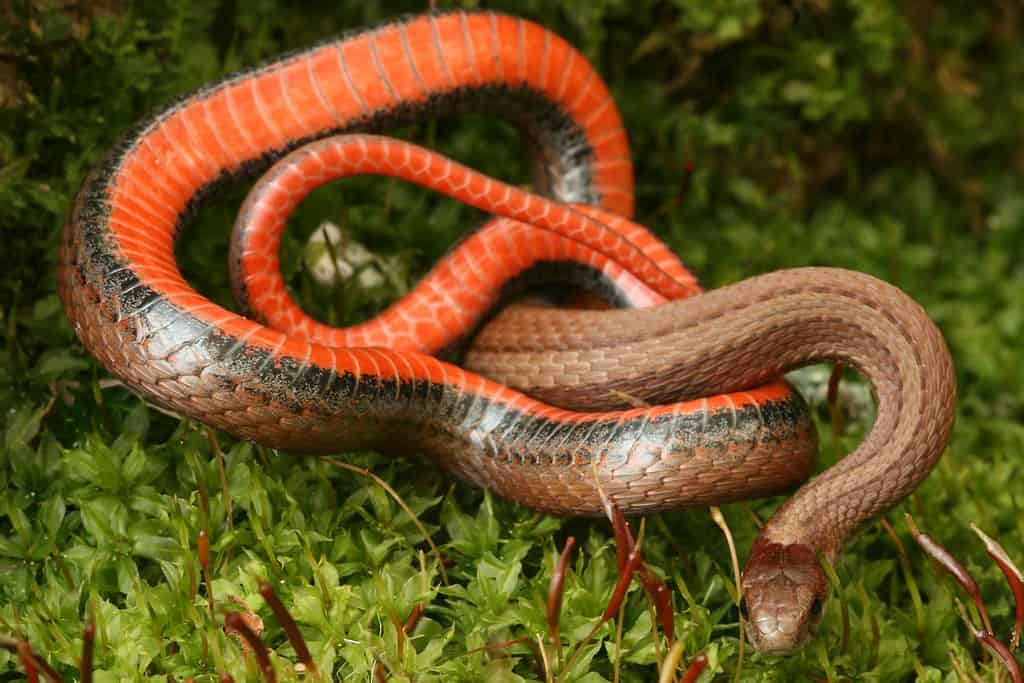
Red-bellied snakes are cousins to Dekay’s brownsnakes.
©Kevin Collison/Shutterstock.com
Just like their cousins Dekay’s brownsnakes, red-bellied snakes are very small and most are less than 12 inches long. However, you won’t miss them because of their distinctive red bellies. Their dorsal color can range from dark olive or gray to almost solid black. But no matter what color its back is, the red-bellied snake a bright red or orange belly.
They are forest dwellers and like to hide under rocks, fallen trees, piles of brush, and dirt. Their diet mostly includes earthworms, snails, and slugs.
Venomous Snakes In New Hampshire
There is only one venomous snake species in New Hampshire and critically endangered. These snakes shun human contact, doing everything they can to stay unnoticed. Because they’re rare and not overly aggressive, bites are rare. That said, if a rattlesnake bites you, it is a medical emergency.
Timber Rattlesnake (Crotalus horridus)

Be careful around Timber Rattlesnakes. They have the ability to inject vast quantities of venom in a single bite.
©Frode Jacobsen/Shutterstock.com
Rattlesnakes are easy to recognize by the sound. However, timber rattlesnakes aren’t as nervous as other snakes, so they usually sit still, trying to stay hidden.
This species has a big, chunky head with huge venom glands and the ability to inject vast quantities of venom in a single bite. Fortunately, they’re not aggressive at all and prefer to be left alone.
Melanism is common in timber rattlesnakes and those living in more northern locations are often almost black. But, if they’re not black, you’ll find a lighter gray to yellowish brown base color with M or V-shaped markings along their back. Even the lighter colored snakes become black toward the tail, which ends in a large rattle.
These snakes are primarily forest-dwellers, using the abundant leaf litter and brush for camouflage while they wait for prey to stumble close enough to grab. When they’re not looking for a meal, timber rattlesnakes bask in the sun and generally try to stay out of everyone’s way.
Other New Hampshire Snakes
There’s no reason to be worried about most of the snakes in New Hampshire. The timber rattlesnake is the only snake that can hurt you ad you’ll probably never see. All others are harmless to you! Here are a few more you may encounter:
Summary Of 5 Snakes In New Hampshire
| Rank | Snake |
|---|---|
| 1 | Northern Black Racer Snake (Coluber constrictor) |
| 2 | Eastern Hognose Snake (Heterodon platirhinos) |
| 3 | Eastern Hognose Snake (Heterodon platirhinos) |
| 4 | Red-Bellied Snake (Storeria occipitomaculata) |
| 5 | Timber Rattlesnake (Crotalus horridus) |
The photo featured at the top of this post is © Tucker Heptinstall/Shutterstock.com
Discover the "Monster" Snake 5X Bigger than an Anaconda
Every day A-Z Animals sends out some of the most incredible facts in the world from our free newsletter. Want to discover the 10 most beautiful snakes in the world, a "snake island" where you're never more than 3 feet from danger, or a "monster" snake 5X larger than an anaconda? Then sign up right now and you'll start receiving our daily newsletter absolutely free.
Thank you for reading! Have some feedback for us? Contact the AZ Animals editorial team.







